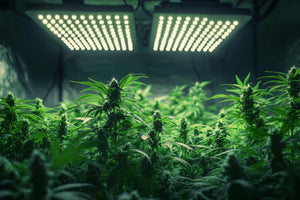Using grow lights for planting has become quite common. But what is the ideal distance between the grow lights and the plants?
Too close or too far can have various impacts on the plants. In this article, we will mainly explore how far away grow lights should be from plants and the effects of lighting being too close or too far.
Why is the Distance between Grow Lights and Plants Important?

When grow lights are too far from plants, what issues can arise?
- The efficiency of photosynthesis decreases, leading to slow plant growth.
- Plants cannot synthesize enough chlorophyll, causing leaves to yellow.
- Plants may exhibit leggy growth, resulting in long stems and sparse leaves.
When grow lights are too close to plants, what problems might occur?
- Leaves can get scorched, with tips or edges turning yellow and dry, and signs of scorching appearing.
- Growth may stagnate; excessive light can stress the plants, causing them to stop growing, and leaves may become wilted or unhealthy.
Thus, whether too far or too close is not ideal. Maintaining an appropriate range is essential for promoting plant growth.
What Factors Influence the Distance?
-
Type of Grow Light: Common types of grow lights include LED grow lights, HPS grow lights, and fluorescent lights. Different fixtures emit varying light intensities, affecting their placement height.
-
Growth Stage of the Plant: Different growth stages require varying light intensities, which in turn affects the distance.
-
Wattage of the Grow Light: Higher wattage lights emit stronger light intensities, necessitating a greater distance to avoid burning the plants.
-
Type of Plant: Different plants require different light intensities. They can be categorized as full-sun, partial-sun, or shade-tolerant plants based on their light needs.
Optimal Distance between Indoor Grow Lights and Plants

Plants need different light intensities at various stages, and you should adjust the grow light intensity to meet their needs.
Seedling Stage: During the seedling stage, keep LED lights at a distance to prevent burning the plants.
| Wattage | Distance |
|---|---|
| 1000W | up to 117 cm |
| 800W | up to 107 cm |
| 600W | up to 97 cm |
| 400W | up to 69 cm |
| 200W | up to 51 cm |
Vegetative Stage: When plants enter the vegetative stage, they require stronger light to promote growth, necessitating increased light intensity.
| Wattage | Distance |
|---|---|
| 1000W | 91-117 cm |
| 800W | 81-107 cm |
| 600W | 76-97 cm |
| 400W | 51-69 cm |
| 200W | 31-51 cm |
Flowering Stage: In the flowering stage, plants require the strongest light to support flower and fruit formation, allowing the LED lights to be placed slightly closer.
| Wattage | Distance |
|---|---|
| 1000W | 53-91 cm |
| 800W | 48-86 cm |
| 600W | 46-76 cm |
| 400W | 33-53 cm |
| 200W | 20-41 cm |
These are suggested distances based on the wattage of grow lights and different growth stages. Of course, you can consult LED grow light manufacturers for additional advice.
Tips for Adjusting the Distance of LED Grow Lights:
-
Observe Plant Growth Conditions: Regularly check the color, shape, and growth rate of the leaves. If leaves turn yellow or growth slows, it may indicate insufficient light, prompting you to shorten the distance between the lights and plants. Conversely, if leaf tips appear dry or scorched, it indicates excessive light, necessitating an increase in distance.
-
Consider the Different Growth Stage Needs: Different plants have varying light needs at different growth stages—seedling, vegetative, and flowering. Adjust the distance accordingly to meet these requirements, and consult LED grow light manufacturers for specific advice.
-
Use Dimmable LED Grow Lights: Choosing dimmable LED lights allows you to control light intensity by adjusting the brightness in addition to changing the distance.
-
Keep a Record of Adjustments: Establish a simple tracking system to regularly record the height of the lights and the plant growth conditions. By comparing growth at different times, you can better understand the impact of light height on plant growth and find the best adjustment strategy.

